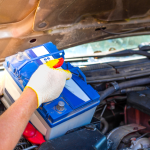Buying a car is a significant decision that can impact your finances and lifestyle for years to come. Whether you’re a first-time buyer or looking to upgrade your current vehicle, timing your purchase can make a world of difference. With so many factors at play—seasonal sales, model year changes, and even economic trends—knowing when to make your move can help you snag the best deal possible.
In this article, we’ll explore the optimal times to buy a car, providing you with insights and tips to ensure you get the best bang for your buck and drive away with a smile. Let’s dive into the factors that can influence your timing and set you on the path to a smart and satisfying purchase!
Table of Contents
- Understanding Seasonal Trends in Car Buying
- Maximizing Savings Through End-of-Year Promotions
- The Impact of New Model Releases on Pricing
- Timing Your Purchase for Optimal Financing Options
- Q&A
- Wrapping Up
Understanding Seasonal Trends in Car Buying
Understanding the nuances of seasonal trends can significantly enhance your car-buying experience. Typically, the best times to purchase a vehicle align with specific periods throughout the year. For instance, year-end sales events and holiday promotions often lead to substantial discounts, as dealerships aim to clear out older inventory to make room for new models. Moreover, the months of September to December are particularly advantageous, as many manufacturers offer incentives to meet sales goals. It’s also worth noting that demand typically dips during the winter months, which can drive prices down, making it an ideal time to negotiate deals.
Additionally, it’s essential to consider the impact of economic cycles and consumer behavior on car prices. During certain periods, such as tax refund season in the spring, many buyers flood the market, resulting in higher prices and less negotiation power for the buyer. Conversely, when new models are introduced, typically in late summer and early fall, dealerships may be more willing to offer discounts on last year’s inventory. To help you visualize the ideal buying timeline, here’s a simple table outlining seasonal trends:
| Season | Trends | Best Buying Strategies |
|---|---|---|
| Winter | Lower demand, end-of-year sales | Negotiate aggressively on leftover stock |
| Spring | Tax refund influx, high demand | Shop earlier and consider used cars |
| Summer | New models arriving, inventory turnover | Look for deals on outgoing models |
| Fall | Clearance sales, dealership quotas | Take advantage of year-end incentives |
Maximizing Savings Through End-of-Year Promotions
As the year draws to a close, many car dealerships ramp up their sales efforts to clear out inventory and make way for the latest models. This period offers a golden opportunity for prospective buyers to snag great deals, often accompanied by substantial discounts, cash rebates, and financing incentives. Take advantage of end-of-year sales events by exploring options that may include:
- Seasonal Promotions: Look for holiday sales that can significantly lower the cost.
- Manufacturer Incentives: Automakers frequently boost their offers in December to hit annual sales targets.
- Dealer Discounts: Local dealerships may offer additional markdowns to clear older models.
To help guide your decision-making, consider creating a comparison table before visiting dealerships. This can help you evaluate each option clearly against factors like price, features, and financing terms. Below is a sample format you can use:
| Car Model | Original Price | Discounted Price | Incentives |
|---|---|---|---|
| Model A | $30,000 | $25,000 | $2,000 Cash Rebate |
| Model B | $28,000 | $22,500 | 0% Financing for 60 Months |
| Model C | $32,000 | $27,000 | $1,500 Trade-In Bonus |
By thoroughly researching available promotions and structuring your comparisons, you can maximize savings and make a well-informed choice, ensuring that your end-of-year purchase is not only economical but also satisfying.
Read More: Jeep 392 Final Edition: Bidding Farewell to an Off-Road Beast
The Impact of New Model Releases on Pricing
The release of new car models can significantly influence pricing strategies across the automotive market. When manufacturers introduce a fresh model, it often leads to a *temporary decrease in prices* for older models as dealerships aim to clear existing inventory. This phenomenon creates an excellent opportunity for savvy buyers looking for deals on vehicles that may still offer great features and reliability, even if they aren’t the latest version. Here are some key points to consider regarding model releases and pricing:
- Increased Discounts: Dealers may offer attractive discounts on outgoing models to make space for new arrivals.
- Limited Inventory: The most popular older models might sell out quickly, increasing competition among buyers.
- Price Stability: New models may stabilize the prices of older ones, preventing drastic drops once the new model hits the showroom.
Additionally, the introduction of new technology and features in upcoming models can also impact the perceived value of older versions. Customers may hesitate to purchase a vehicle that will soon be overshadowed by a cutting-edge replacement, leading to further price reductions. Furthermore, manufacturers often strategically schedule model releases to align with seasonal trends and fiscal quarters, allowing buyers to anticipate the best timing for their purchases. The following table outlines key factors to keep in mind relating to model release timing:
| Timing | Pricing Effects |
|---|---|
| Before New Model Launch | Higher prices for current models due to demand |
| After New Model Launch | Price discounts on outgoing models |
| Seasonal Sales Events | Increased promotions, enhancing savings |
Timing Your Purchase for Optimal Financing Options
Finding the right moment to purchase your vehicle can significantly impact your financing options. Many experts suggest aiming for the end of the month or the end of the year when dealerships are eager to meet sales quotas. During these periods, they may be more willing to negotiate pricing and offer favorable financing terms. Additionally, shopping during holiday weekends or major sales events can also yield substantial markdowns, as dealerships often offer promotional financing rates that can save you money in the long run.
Another critical factor to consider is the timing of new model releases, typically occurring in late summer or early fall. When manufacturers unveil the latest models, dealerships often discount previous year models to clear inventory. This can lead to excellent financing deals if you are open to buying slightly older models. Keep an eye out for local promotions and manufacturer incentives, which can change frequently and provide you with the best available financing options. Here are some key times to consider:
- End of the month: Sales targets may lead to better deals.
- Holiday weekends: Special sales events often feature attractive financing.
- New model release periods: Previous models may be discounted.
Q&A
Q&A:
Q1: What time of year is generally considered the best for buying a car?
A1: The best time of year to buy a car is typically at the end of the year, specifically between October and December. Dealerships are often looking to clear out their old inventory to make room for new models, which can lead to significant discounts and promotions. Additionally, many dealerships have year-end sales quotas that they want to meet, making them more willing to negotiate.
Q2: Are there specific months that are better than others?
A2: Yes! In addition to late December, the end of each quarter (March, June, September, and December) is also a great time to buy. Salespeople and dealerships usually have monthly and quarterly sales goals, which can result in better deals during these periods. Furthermore, shopping during holiday sales events like Memorial Day, Labor Day, and the Fourth of July can yield extra savings.
Q3: Does the day of the week matter when buying a car?
A3: Absolutely! Tuesdays and Wednesdays are often considered the best days of the week to buy a car. Dealerships tend to be less busy during these weekdays, meaning you’ll likely receive more personalized attention and have more time to negotiate. Plus, sales teams might be more willing to make a deal as they look to boost sales early in the week.
Q4: What about the time of the month—should I wait until the end of the month to buy a car?
A4: Yes, waiting until the end of the month can be advantageous. Salespeople may be eager to meet their monthly targets, which can result in more flexible pricing and greater chances for negotiation. If you can time your purchase for the last few days of the month, you may benefit from these incentives.
Q5: Are there specific times to avoid when buying a car?
A5: It’s wise to avoid shopping during peak times, such as weekends and during major holidays when dealerships are crowded. You might find less room for negotiation when salespeople are busy with multiple customers. Additionally, avoid shopping in the early months of the year, as new model releases can mean higher prices and fewer discounts.
Q6: How does the season affect car prices?
A6: Seasonal trends can notably impact car prices. For example, convertibles and sports cars may be in higher demand during the summer, while four-wheel-drive vehicles are sought after in winter. If you’re flexible with the type of vehicle you want, shopping during the off-season for a particular model can lead to better deals.
Q7: Are there any other tips I should keep in mind?
A7: Definitely! Always do your research before purchasing. Websites that track price trends can help you determine the average market price for the car you want. Additionally, be prepared to walk away if you don’t feel the deal is right—this can give you leverage in negotiations. It’s also wise to consider financing options ahead of time, as having pre-approved financing can put you in a stronger position when making a deal.
Q8: Lastly, should I buy new or used, and does the timing change?
A8: The timing can vary slightly between new and used cars. For new cars, follow the recommendations above. For used cars, consider shopping during the spring and summer as more people typically sell their vehicles during this time, leading to a wider selection and better deals. Regardless of new or used, it’s always essential to shop around and compare prices.
Now that you have a better understanding of timing and strategies, you’re ready to make your next car-buying experience enjoyable and budget-friendly! Happy car hunting!
Wrapping Up
finding the best time to buy a car involves a careful consideration of various factors, including seasonal trends, dealership promotions, and your own financial readiness. Whether you choose to shop at the end of the month, during holiday sales, or even during model year transitions, timing can significantly impact the price and overall deal you receive. Remember, the key is to do your research, stay informed about market conditions, and be prepared to negotiate. By taking these steps, you can ensure that your car-buying experience is not only enjoyable but also financially advantageous. Happy car shopping, and may you find the perfect ride that fits your needs and budget!











